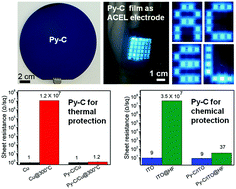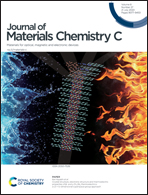High-performance transparent conductive pyrolyzed carbon (Py-C) ultrathin film†
Abstract
Pyrolyzed carbon (Py-C) film, a member of graphene family, has not been paid significant attention despite its potential advantages in synthesis procedure and opto-electro-mechanical properties. This academic indifference is due to the lack of a low-cost synthesis method for Py-C ultrathin films whose properties are comparable to those of graphene. In this study, we proposed the direct synthesis of Py-C ultrathin films on various target substrates. We produced a hydrogenated amorphous carbon (a-C:H) ultrathin film in a microwave oven and used it as a transferable precursor film for conversion into the Py-C ultrathin film. The thickness of the Py-C ultrathin film was controlled in the range of 0.7–12 nm. The Py-C ultrathin film has opto-electro-mechanical properties comparable to those of graphene, work function (4.57 eV) similar to that of graphene, high transparency with a relatively low sheet resistance (83% at 1.1 kΩ sq−1), excellent flexibility, stable electrical resistance upon folding, anti-oxidation, and chemical protection. This Py-C ultrathin film is expected to find various practical applications as an alternative to graphene. As an example, we demonstrated a highly flexible pixelated display fabricated using the Py-C ultrathin film as an electrode for alternating current electroluminescent (ACEL) devices.



 Please wait while we load your content...
Please wait while we load your content...